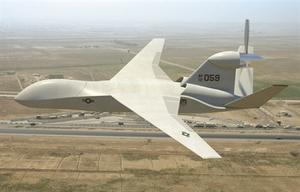UAV updateU.S. military looking for sturdier, more survivable UAVs
The U.S. military is looking for sturdier, more survivable UAVs; the military regards the airspace over Pakistan and Afghanistan as “permissive environment” — and it wants UAVs to be able to do their work in what it describes as “contested airspace”

The next generation MQ-X UAV in trials // Source: blogspot.com
The U.S. Air Force’s unclassified effort to field a next generation UAV, dubbed MQ-X, has been on hold for nearly a year now, but the service’s top requirements officer weighed in the other day on what he thinks the plane should be capable of.
“We need to look at bridging from the permissive environment” today’s drones like the MQ-1 Predator and MQ-9 Reaper fly in over places like Afghanistan and “contested airspace” where something like a Reaper would make easy prey, Lt. Gen. Philip Breedlove, the Air Force’s chief of operations, plans and requirements for the U.S. Air Force said during a breakfast with reporters in Washington, D.C.“We need a capability in that area and I think MQ-X is a good place to have that conversation.”
Defense Technology reports that in fact, combatant commanders around the world are already starting to ask for something more survivable than our existing drones, according to Breedlove.
From his perspective, the plane would not necessarily be high-end stealth, but it would be more survivable than the current crop of propeller-driven UAVs prowling the skies of the Middle East.
The Air Force is already working on capabilities that can go into extremely heavily defended regions, but needs something that can handle less heavily defended but still dangerous airspace, according to Breedlove.
He did not elaborate on what he meant by more survivable, but Defense Technology’s John Reed has heard senior Air Force officials talk about the need to make next-generation UAVs such as MQ-X faster, more maneuverable, and equipped with countermeasures or maybe air-to-air weapons.
The general did not give a timeline for when he thought the service will have hashed out what it wants the drone to look like.
“This makes me wonder,” reed writes. “What about all those next-generation Unmanned Combat Air Vehicles being designed?”
The U.S. Navy is already looking to capitalize on that type of design for its Unmanned Carrier Launched Surveillance and Strike UAV which it hopes to have in limited service by the end of this decade. “Is such a plane too expensive for MQ-X style missions?” Reed asks, and adds: “Also, I’m curious, what category of survivability does the stealthy-looking RQ-170 actually fall under?”
